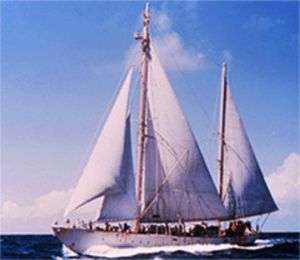RV Atlantis
RV Atlantis is a sailboat that served as the first and also the main research vessel for the Woods Hole Oceanographic Institution from 1931 to 1964. Several ships, including RV Atlantis (AGOR-25) and the Space Shuttle Atlantis (OV-104) were named after Atlantis.[1] The former Atlantis is now commissioned as an oceanographic research vessel in the Argentine Naval Prefecture as the Dr. Bernardo A. Houssay. Having sailed over 1,300,000 miles to date, she is the oldest serving oceanographic research vessel in the world.
 RV Atlantis | |
| History | |
|---|---|
| Name: | RV Atlantis |
| Owner: | Woods Hole Oceanographic Institution |
| Ordered: | 1930 |
| Builder: | Burmeister & Wain, Copenhagen, Denmark |
| Yard number: | 596 |
| Laid down: | 1930 |
| Launched: | December 1930 |
| In service: | 1931 |
| Out of service: | 1964 |
| Name: | El Austral |
| Owner: | Consejo Nacional de Investigaciones Cientificas y Técnicas (CONICET) |
| Acquired: | July 1966 |
| In service: | 1966 |
| Identification: |
|
| Status: | Active |
| General characteristics | |
| Tonnage: | 312 BRT |
| Displacement: | 460 tons |
| Length: | 143' 6" |
| Beam: | 29 ft |
| Draft: | 18 ft |
| Propulsion: | 280 HP B&W diesel |
| Sail plan: | Marconi Ketch |
History
Atlantis was the first Woods Hole Oceanographic Institution research vessel and the first ship built specifically for interdisciplinary research in marine biology, marine geology and physical oceanography. The 460-ton Marconi Ketch originally carried a crew of 17 and had room for 5 scientists.[2] Columbus Iselin II, her first master and a major influence in her design, felt that steadiness, silence and cruising range were of greater importance than speed. After her construction was complete, WHOI searched for an appropriate name for the new vessel. Alexander Forbes (1882–1965), a trustee of WHOI, had recently bought a schooner named Atlantis from Iselin. Mr. Forbes rechristened his schooner so the new research vessel could be named Atlantis.
Use of a continuously recording fathometer on Atlantis cruise No. 150 enabled Ivan Tolstoy, Maurice Ewing, and other scientists of the Woods Hole Oceanographic Institution to locate and describe the first abyssal plain in the summer of 1947.[3][4] This plain, located to the south of Newfoundland, is now known as the Sohm Abyssal Plain.[4] Following this discovery many other examples were found in all the oceans.[5][6][7][8][9]
The "A- boat" made 299 cruises and covered 700,000 miles, doing all types of ocean science.
Argentine service
In 1966, Atlantis was sold to Argentina, refurbished, and renamed El Austral. She was used as a research vessel by the CONICET, crewed by Argentine naval personnel. In 1996 she was registered as a civilian ship under the name Dr. Bernardo A. Houssay and manned by the Argentine Naval Prefecture. She was overhauled and refurbished in 2009 at the Tandanor shipyard in Buenos Aires.[10][11]
References
- "Space Shuttle Atlantis Orbiter Fleet". Retrieved 29 June 2010.
- Jenkins, Dennis R. (2007). Space Shuttle: The History of the National Space Transportation System. Voyageur Press. ISBN 978-0-9633974-5-4.
- P.P.E. Weaver; J. Thomson; P. M. Hunter (1987). Geology and Geochemistry of Abyssal Plains (PDF). Oxford: Blackwell Scientific Publications. p. x. ISBN 978-0-632-01744-7. Archived from the original (PDF) on 24 December 2010. Retrieved 18 June 2010.
- Ivan Tolstoy & Maurice Ewing (October 1949). "North Atlantic hydrography and the mid-Atlantic Ridge". Geological Society of America Bulletin. 60 (10): 1527–40. doi:10.1130/0016-7606(1949)60[1527:NAHATM]2.0.CO;2.CS1 maint: ref=harv (link)
- Bruce C. Heezen, Maurice Ewing and D.B. Ericson (December 1951). "Submarine topography in the North Atlantic". Geological Society of America Bulletin. 62 (12): 1407–1417. doi:10.1130/0016-7606(1951)62[1407:STITNA]2.0.CO;2.CS1 maint: ref=harv (link)
- Bruce C. Heezen, D.B. Ericson and Maurice Ewing (July 1954). "Further evidence for a turbidity current following the 1929 Grand banks earthquake". Deep-Sea Research. 1 (4): 193–202. doi:10.1016/0146-6313(54)90001-5.CS1 maint: ref=harv (link)
- F.F. Koczy (1954). "A survey on deep-sea features taken during the Swedish deep-sea expedition". Deep-Sea Research. 1 (3): 176–184. doi:10.1016/0146-6313(54)90047-7.CS1 maint: ref=harv (link)
- Bruce C. Heezen; Marie Tharp & Maurice Ewing (1962). "The Floors of the Oceans. I. The North Atlantic. Text to Accompany the Physiographic Diagram of the North Atlantic". In H. Caspers (ed.). Heezen, Bruce C., Marie Tharp, and Maurice Ewing: The Floors of the Oceans. I. The North Atlantic. Text to Accompany the Physiographic Diagram of the North Atlantic. With 49 fig., 30 plates. – New York, N.Y.: The Geological Society of America, Special Paper 65, 1959. 122 p. $10.00. Internationale Revue der Gesamten Hydrobiologie und Hydrographie. 47. Weinheim: WILEY-VCH Verlag GmbH & Company. p. 487. doi:10.1002/iroh.19620470311. Retrieved 26 June 2010.
- Bruce C. Heezen & A.S. Laughton (1963). "Abyssal plains". In M.N. Hill (ed.). The Sea. 3. New York: Wiley-Interscience. pp. 312–64.
- "Un barco con historia, remodelado para investigar el mar". Clarin.com. 21 October 2009.
- "Prefectura launched 'Dr. Bernardo Houssay' oceanographic vessel". Prefectura Naval Argentina (Argentine Coast Guard). Retrieved 28 October 2009.
Bibliography
| Wikimedia Commons has media related to Atlantis (ship, 1930). |
- Susan Schlee (1978). On Almost Any Wind: The Saga of the Oceanographic Research Vessel "Atlantis". Cornell University Press. ISBN 978-0-8014-1160-1.
- Wallace O. Fenn (1969). Alexander Forbes (1882–1965): A Biographical Memoir (PDF). Washington DC: National Academy of Sciences.